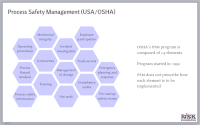Risk regulation, liability and insurance as risk treatment mechanisms
Overview
 Society uses multiple mechanisms to control the risk of
hazardous activities:
Society uses multiple mechanisms to control the risk of
hazardous activities:
- regulation: technological or organizational prescriptions
- liability regimes such as tort law: obligation to compensate victims
- soft law and self-regulation: voluntary standards of behaviour associated with social sanctions for firms that do not engage in the process
- insurance to ensure that victims are compensated for the monetary component of a loss
This slideset describes these different mechanisms and attempts to answer:
what are the advantages and disadvantages of each mechanism?
to what extent are they complementary?
This submodule is a part of the risk management module.
Course material
 |
Risk regulation, liability and insurance as risk treatment mechanisms |
What is regulation? A set of obligations imposed by public law and enforced by public officials designed to induce individuals and firms to outcomes which they would not voluntarily reach, but are in the public interest. Compliance is aided by the threat or imposition of some sanction (fines, closure of activity…). Risk regulation, or the public management of hazards which could affect public health, safety and the environment, is an important proportion of all regulation (roughly half of EU legislation, for example…).
There are different forms of safety regulation:
Prescriptive or “command and control”: the regulator sets specific requirements for regulated firms, such as technological measures or design features for equipment. This form of regulation allows clarity in requirements and fairness (all firms must respect the same requirements), but tends to lead to outdated regulations which don’t follow technological innovation and to prevent firms from experimenting with innovative safety mechanisms.
Goal-based, or performance-based, or outcome-based: the regulator establishes specific desired and measurable outcomes for regulated activities, without requiring specific ways of achieving them. This allows firms to select the most effective measures to reach the objective and tends to lead to improved “ownership” of safety measures, since they are chosen by company managers. However, it’s not always easy to specify goals that are both safety-relevant and measurable.
Activity-based or management-based: the regulator requires firms to implement key processes that are expected to improve safety performance, such as a Safety Management System (SMS). This allows the regulator to avoid setting specific technological or performance goals, and to establish a conversation with regulated firms concerning their management activity, but it is not necessarily effective in ensuring good safety performance (management-based processes can sometimes operate in an apparently effective manner but have very little effect on real safety-related decisions and front-line activity).
Information-based or mandatory disclosure regimes: the regulator requires firms to disclose information on the risks of their products (labelling standards, publication obligations) and the environmental impact of their operations. For example, US OSHA’s Hazard Communication Standard specifies workers’ “right to know” about long-term health risks resulting from workplace activity and products to be labelling with information on hazards.
Soft law approaches such as labels or voluntary sector-specific standards allow the firms from a specific industry sector (who are assumed to possess professional pride and interest in maintaining the reputation of their profession/sector) to set common standards and codes of practice that firms voluntarily adopt. These mechanisms, though much less costly to enforce and more flexible with respect to technological changes, do not necessarily ensure social control over hazards and do not provide a mechanism for the public to hold firms accountable for the risks they generate.
Other resources
We recommend the following sources of further information on this topic:
OECD report Risk and Regulatory Policy: Improving the Governance of Risk, 2010
FonCSI report Risk regulation, liability and insurance: literature review of their influence on safety management, E. Marsden, 2014
Published:
Last updated: